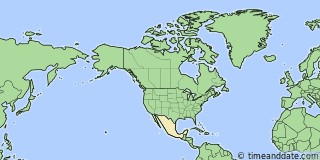Oct 30, 2022, 2:00 am
| Country: | Mexico |
|---|---|
| Long Name: | United Mexican States |
| Abbreviations: | MX, MEX |
| Capital: | Mexico City |
| Time Zones: | 3 |
| Dial Code: | +52 |
Note: Some regions of Mexico use a different period of DST than shown below.
Apr 4
Forward 1 hour
Apr 4, 2010 - Daylight Saving Time Started
When local standard time was about to reach
Sunday, April 4, 2010, 2:00:00 am clocks were turned forward 1 hour to
Sunday, April 4, 2010, 3:00:00 am local daylight time instead.
Sunrise and sunset were about 1 hour later on Apr 4, 2010 than the day before. There was more light in the evening and less light in the morning.
Also called Spring Forward, Summer Time, and Daylight Savings Time.
Oct 31
Back 1 hour
Oct 31, 2010 - Daylight Saving Time Ended
When local daylight time was about to reach
Sunday, October 31, 2010, 2:00:00 am clocks were turned backward 1 hour to
Sunday, October 31, 2010, 1:00:00 am local standard time instead.
Sunrise and sunset were about 1 hour earlier on Oct 31, 2010 than the day before. There was more light in the morning and less light in the evening.
Also called Fall Back and Winter Time.
When Does DST Start and End in Mexico?
Most of Mexico, including its capital Mexico City, doesn't use Daylight Saving Time (DST). However, some exceptions exist for the locations that follow the DST schedule of the United States:
- Baja California observes DST and uses the same time zones as neighboring California in the US. Here, the DST period starts on the second Sunday in March and ends on the first Sunday in November.
- Sonora does not change its clocks to stay in sync with the neighboring US state of Arizona, where Mountain Standard Time (MST) is observed all year.
- Municipalities near the country's northern border with the US keep the DST schedule for practical and socioeconomic reasons. This includes the municipalities Ciudad Juárez and Ojinaga in Chihuahua, Colombia in Nueva Leon, and Reynosa in Tamaulipas.
Which States and Federal Districts use Daylight Saving Time in 2010

Areas in Mexico on standard time all of 2010
DST in States and Federal Districts in Mexico in 2010 (32 in total, 31 where all observe DST, 1 which doesn't observe DST) | |||||
|---|---|---|---|---|---|
| Aguascalientes | Apr 4 – Oct 31 | Guanajuato | Apr 4 – Oct 31 | Querétaro | Apr 4 – Oct 31 |
| Baja California | Mar 14 – Nov 7 | Guerrero | Apr 4 – Oct 31 | Quintana Roo | Apr 4 – Oct 31 |
| Baja California Sur | Apr 4 – Oct 31 | Hidalgo | Apr 4 – Oct 31 | San Luis Potosí | Apr 4 – Oct 31 |
| Campeche | Apr 4 – Oct 31 | Jalisco | Apr 4 – Oct 31 | Sinaloa | Apr 4 – Oct 31 |
| Chiapas | Apr 4 – Oct 31 | Michoacán | Apr 4 – Oct 31 | Sonora | No DST |
| Chihuahua (north) | Mar 14 – Nov 7 | Morelos | Apr 4 – Oct 31 | Tabasco | Apr 4 – Oct 31 |
| Chihuahua | Apr 4 – Oct 31 | México | Apr 4 – Oct 31 | Tamaulipas (north) | Mar 14 – Nov 7 |
| Ciudad de México | Apr 4 – Oct 31 | Nayarit | Apr 4 – Oct 31 | Tamaulipas | Apr 4 – Oct 31 |
| Coahuila de Zaragoza (north) | Mar 14 – Nov 7 | Nuevo León (north) | Mar 14 – Nov 7 | Tlaxcala | Apr 4 – Oct 31 |
| Coahuila de Zaragoza | Apr 4 – Oct 31 | Nuevo León | Apr 4 – Oct 31 | Veracruz | Apr 4 – Oct 31 |
| Colima | Apr 4 – Oct 31 | Oaxaca | Apr 4 – Oct 31 | Yucatán | Apr 4 – Oct 31 |
| Durango | Apr 4 – Oct 31 | Puebla | Apr 4 – Oct 31 | Zacatecas | Apr 4 – Oct 31 |
Daylight Saving Time History in Mexico
- Mexico first observed Daylight Saving Time in 1931.
- Mexico has observed DST for 67 years between 1931 and 2024 (DST in at least one location).
- Previous time with no Daylight Saving Time was 1975.
- See Worldwide DST Statistics
Baja California Pioneered DST
The state of Baja California introduced seasonal clock changes in 1931, remaining the only area in Mexico with a DST schedule for 65 years.
In the rest of the country, DST was introduced in 1996 and removed in 2022.
